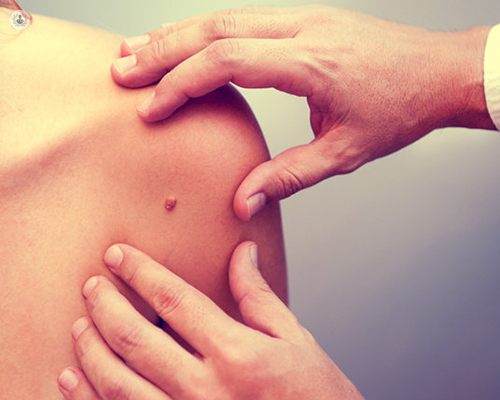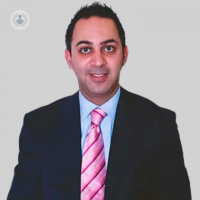A deep dive into cyst removal: part 1
Escrito por:Cysts can be an unwanted surprise, leading to discomfort and sometimes even pain. In the first article of a two-part series, experienced cosmetic dermatologist Dr Simon Zoakie explores cysts, explaining the various types, cysts and causes, as well as treatment options.

Understanding cyst types and causes
Cysts are fluid-filled lumps that form beneath the skin, and their treatment varies depending on the type and underlying causes. There are several common types of skin cysts, such as:
- Epidermoid cysts: these are typically found on the face, neck, chest, and shoulders and often associated with acne.
- Pilar cysts: these form around hair follicles and are commonly seen on the scalp.
- Sebaceous cysts: Also known as epidermal, keratin, or epithelial cysts, these result from the multiplication and inward migration of skin cells instead of their normal shedding process.
In certain cases, cyst removal surgery may be necessary, depending on factors such as the cyst's size, location, and the level of discomfort it causes. While not all cysts require immediate medical intervention, it is advisable to seek professional evaluation for most cases. This precaution is crucial because cysts can become infected or inflamed, causing pain and tenderness. Prompt medical advice is essential to secure correct treatment and avoid additional complications.
Are there any non-surgical cyst removal methods?
There are several non-surgical options to remove cysts, such as drainage, needle aspiration and remedies. However, before taking matters into your own hands, you must consult with a doctor, to avoid complications, and ensure correct treatment.
Drainage
Drainage is a common technique for removing cysts without resorting to surgery. This process involves the administration of local anaesthesia and a small incision to carefully express the cyst, minimising harm to hair follicles. It's important to note that drainage is not recommended for epidermoid and pilar cysts, due to their tendency to regrow after the procedure. While drainage offers temporary relief, it's not a permanent solution; complete removal of the cyst, including its sac, is essential to prevent recurrence.
Needle aspiration
Needle aspiration is an alternative non-invasive method for cyst removal. In this procedure, a physician uses a slender needle to puncture the cyst and extract its fluid, sometimes using a syringe for removal.
The primary advantage of needle aspiration lies in its non-invasive nature, with minimal potential risks. However, there are potential risks such as infection, bleeding, and scarring. Before undergoing needle aspiration, it's crucial to disclose any medications or allergies to your doctor for a safe and customised procedure.
Home remedies
While some cysts may respond to home remedies, it's crucial to consult a doctor before attempting any self-treatment. A medical professional can offer a specific diagnosis and treatment plan based on the cyst's location and cause, guiding you through the removal process more effectively. Attempting to remove a cyst without professional guidance may lead to increased damage or infection. You must prioritise your health and seek professional advice before considering any home remedies for cyst removal.
Surgical cyst removal procedures
When non-surgical approaches prove insufficient, surgical procedures become necessary for cyst removal. These procedures vary based on the cyst's location and severity, encompassing facial and scalp cyst removal, body cyst removal, and the removal of infected or inflamed cysts.
Facial and scalp cyst removal
Specialised surgical techniques are employed for facial and scalp cysts to minimise scarring and preserve hair follicles. The meticulous nature of these procedures ensure the removal of cysts, such as milia, without leaving visible scars. In certain cases, medical therapy may precede surgical removal, particularly for acne cysts. Concurrent treatment of multiple scalp cysts is feasible for efficient and effective results.
Body cyst removal
Various surgical techniques are employed for removing body cysts, depending on size and location. These techniques include removing the cyst under local anaesthesia, making a small incision to access the cyst, and ensuring complete extraction of the cyst, including its sac, to prevent recurrence. Tailoring the surgical approach to the specific characteristics of the cyst optimises outcomes.
Infected and inflamed cyst removal
Careful treatment is required for infected and inflamed cysts, often involving inflammation and infection control before removal. Signs of infection and inflammation, such as redness, swelling, pain, and discharge, guide the treatment. Options include draining swollen or infected cysts, and in certain cases, surgical removal may be necessary. Swift treatment is crucial to prevent complications and alleviate discomfort.
Preventing cyst recurrence
Preventing cyst recurrence involves appropriate aftercare and understanding the underlying causes of cyst formation. Thorough removal of the entire cyst, including its sac, minimises recurrence risk. Home care involves cleaning the cyst and its surrounding area with warm water, followed by gentle drying with a clean cloth, cotton wool, or medical dressing.
Understanding the causes, such as abnormal skin cell migration, enables preventative measures in daily routines, coupled with proper aftercare, significantly reducing the risk of cyst recurrence.
If you would like to book a consultation with Dr Zokaie, do not hesitate to do so by visiting his Top Doctors profile today


